Don't wanna be here? Send us removal request.
Link
0 notes
Photo
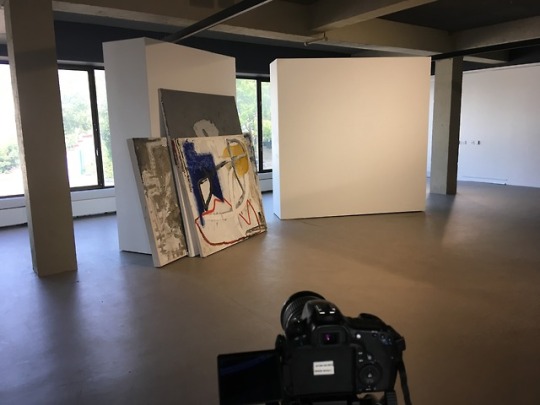
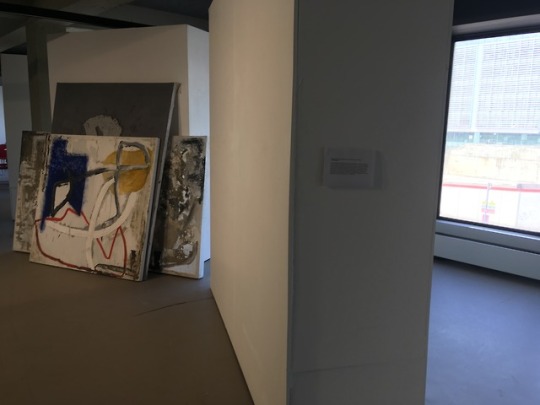
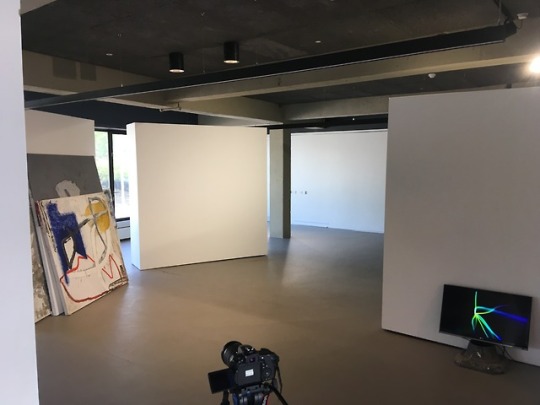
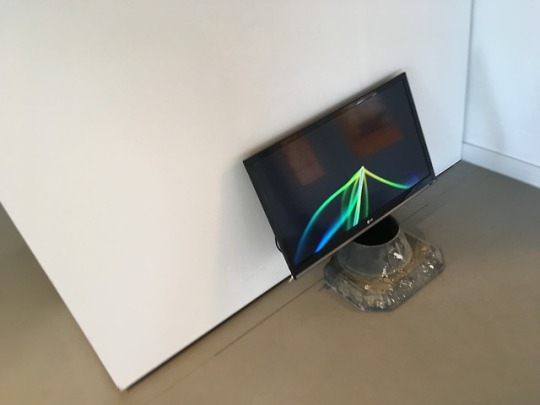
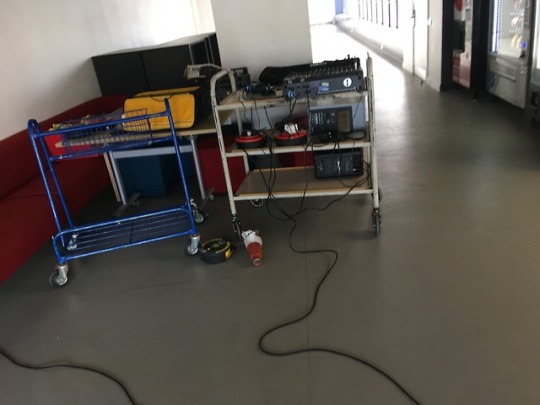
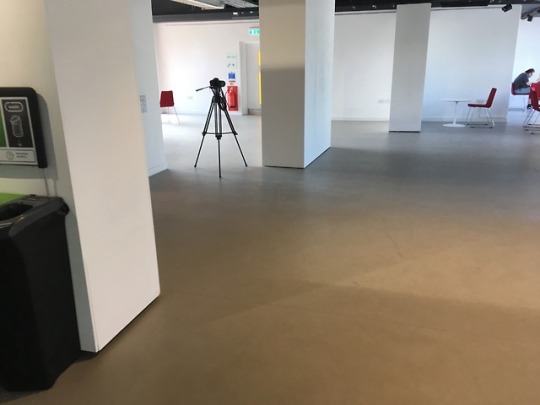
Documentation of the (mock) installation of Adjacent To It--Concrete--Whereby It Never Existed
0 notes
Text
Conceptual Statement
//Adjacent To It-Concrete-Whereby It Never Existed//
This work functions on a 6 day cycle. The duration of this piece is fundamental in reflecting the flows and marks made habitually as we negotiate the urban environment. The city. Working through the 6 days with the mediums: painting, sound, video & performance, I construct an installation where I, the artist intervene, producing a rhetoric within these mediums. To discuss the relationships of the mediums separate from one another and then to discuss their inter-relationships between them will be fruitful in understanding the concept of my piece.
The 3 paintings in my piece vary through my aesthetic and compositional use of the material concrete. Each one representing an abstraction of the transient marks left as we negotiate the urban space. Their function as a painting and the marks contained within the surface, is repurposed as both an object and as a sound. Liberating painting from its visual language through the use of contact mic’s to translate the marks into sound, ultimately free’s them from the canvas into the ephemeral space of sound. Repurposing them in this way, is a direct statement by the artist at the hierarchical value of painting through history.
Using sound from the paintings to build up an ambience and noise, the artist aims to immerse the audience into an environment that exaggerates the chaotic sounds found within the city. The inanimate objects of our daily life within a city exists without life. However, we often perceive them to have a meaning constructed by semiotics and sound. I am mirroring this relationship with objects in life, into my artistic practice. By producing sound from the marks within the paintings, I am offering the audience my perception of this phenomena. This perception is open for interpretation in the same way that the audience may interpret the objects in their daily lives.
The performance created from using contact mic’s upon paintings, allows the artwork to be in the process of production. It is directly by showing the relationship of these two mediums operating as a whole, that allows the painting to be considered as an object. During the exhibition, over 6 days, a new painting is performed, this cycle represents a continuous period of time that is in flux. The artist acts as the communicator of this concept present in the work. This relationship of the artist to his work during this cycle, reflects as an example of the habitual process that exists within our daily life. The performance is captured and freed from time, through the use of a DSLR recording. This document is a means to mediate the artwork whilst he is not present during the exhibition.
From capturing this whole process within the performance, it allows the artist to form negative space whilst he is not present during the exhibition. He takes the 30 minute recording and immediately plays it back on a monitor opposite to the paintings. This action allows the artwork to be in a continuous cycle whilst he is not present during the day. However, there is always a distinct tension created by this process, as the video is always one step behind the performance. Time within this work is fractured, leaving the echo or mark of the artists presence in the space. By culminating all of these mediums together in a specific configuration, Adjacent to it- Concrete-Whereby it never existed; is produced. It is on the 6th day of the exhibition where the cycle ends and the work in complete.
0 notes
Link
0 notes
Link
0 notes
Link
0 notes
Text
Tutorial 5
This is going to be a brief overview of the tutorial i had with mikhail today.
For this tutorial myself and mikhail have it via FaceTime as for circumstances i needed to be in London. What we had spoken about before in emails following up to the tutorial was very important as it gave us something direct to discuss about the work. What i wanted to discuss was the very important relationship of all the mediums that operate in my piece on a conceptual level.
I explained to him my idea of a cycle in the piece and the work being temporal through the use of video documenting the work in the piece. We also discussed how the longevity of the work was crucial for thinking about how this will be assessed by himself and Matthew. For the assessment i will have a piece of the cycle documented as a performance so that the work is shown in a segment of what will be 6 segments.
I also explained how the importance of the use of the marks made in the paintings was removed via the performance with the contact mic, and seeing how I'm directly referencing Robert Rauchenbergs piece where he erased a Decoonning painting. Through the cycle each painting will be come more and more erased until the final day of the 6 day cycle the only visible markings on the work will be that of the negative space left as the markings in paint are removed. This use of erasing the work also alluded to how the piece is in a constant state of being fractured by the artist and is also about the use of time and the relationship of the artist to his own work over time. It also looks at the history of abstract expressionism and wants to create a very clear stand on it by doing a similar action of eraser, the difference in my work is that I'm doing it to my own work, I'm refusing for the paintings to be subjected to be viewed purely as a painting; wanting more from the legacy of painting and doing this by trying to add the ephemeral and transience of sound to the piece. Through sound the work becomes a statement and a direct abrasiveness of my view of paintings hierarchy in fine art. The historical power that they hold across all the other mediums and that i want there to be a new space to be explored across the multi-diciplary arts and how painting can be used in this way, to gain new power.
I'm very aware of how close i am to assessment and how my ideas on the work have become clearly confused along the way, but this is a positive as it allows the piece now to reach a totality because of my clarity of concept.
Mikhail was very helpful as a lecture and has continually been a great source of inspiration. I want to thank him for his support :) hopefully myself and him will cross paths as practitioners.
0 notes
Link
0 notes
Link
0 notes
Link
0 notes
Text
Conceptual relevance of video in the work.
For sometime with this piece I have been quite ambivalent towards to video in my work. What the film has done before now is just act as a visual reference to the material. However now that I have considered it and thought very carefully about how it operates with the other mediums, I have come up with the reasoning/solution.
The work will be exhibited for 6 days during the show. There are 3 paintings being performed in the work each separate from one another. This is to carefully examine each works sound and its use as an object in the performance. Each day there will be a performances involving 1 painting. This will be recorded in the show and played when the artist is not present in the work. However the performances seen in the video is always one step behind the actual performance. Hinting to a sense of negative space, where all of the mediums are able to combine through time in video. The Video in this way is a constant attempt to hold something when I'm not present in the work. Holding all of the separate mediums that can only be performed in the moment of the performance.
When the performance occurs each day in the exhibition, the video will be switched of and a DLSR will record the performance that is to push the work onwards through its cycle of 3 paintings, witch are performed twice during the show, allowing the full cycle and longevity of the work to be seen. on the Saturday the 9th the piece will have reached its completion in a the cycle of video and live performance.
It has been through testing the setup and seeing how video operates that I have come to this conclusion of how video operates. It is the glue between the mediums, painting, sound, performance and myself, allowing these all to be fractured across the 6 day period of the show.
For the submission of the work on the 18th I will show a mock version of this whole work in the form of a 3 hour film containing all of the video material that is produced, as a means of assessment in the degree.
0 notes
Link
0 notes
Link
http://www.belgiumishappening.net/home/publications/1958-00-00_kaprow_legacypollock a
a link to the full essay by Alan Kaprow on Jackson Pollock
0 notes
Link
0 notes
Text
The Phenomenology of the Music-listening Experience Marian T. Dura
This research is interested in the way it had brought me to think about my work. Often when thinking about music we do not think about its relationship to art as it doesn't have a physical object witch we can identify a meaning too directly. Sound is not an (Art Object) it is a experience that is highly subjective and is due to the disposal of visual hierarchy.
So In my work one can say that my paintings function is to comment of the process of viewing paintings being dominated by the visual phenomena. I suggest that sound as an element of painterly abstraction is fruitful. As the Mind of the artist when producing these aesthetic compositions may be the direct wanderings as it experiences the phenomenon of silence in painting. So thus the sound produced when using a contact microphone in this scenario is the headspace or the aesthetic composition of the artist in time and sound.
The way that I aim to elude to this is through the active procedure of performing the marks and gestures. To not reject abstract expressionism or any historical reference point of my work. But actually to deduct a new movement from this thinking of aesthetics and sound. Similar to the work of sythnesia- but in reverse and in a more literal sense.
“In the phenomenological approach, Smith says, “We let things—including other humans—speak for themselves instead of dictating to them from pre- fabricated cultural and metaphysical categories. Thus instead of trying to cast music in a spatial form, which is visu- ally oriented, we let it speak in its own form.”17 This de-emphasis of the visual in favor of the inclusion of the auditory becomes a major contribution of Smith’s: “In seeking to broaden the spectrum of phenomenology, we thus realize the need to expand its conceptu- ality and language beyond light and sight metaphor. This must then lead to a redefinition of phenomenology in terms of not only phenomena but also of aku- mena”18 (emphasis in original).
2. Aisthesis versus aesthetics. Smith’s appeal for a return to the musi- cal experience itself as a means of dis- covering the inner meaning of music calls for
an overcoming of the merely theoretical and abstract approach to things. For esthet- ics has really been the “metaphysics” of esthesis, that is, it has led us away from the primordial experience of music as such into the realm of intellectualisms, and this under the guise of restoring to musicology some of its lost subjectivity. . . . [T]radi- tional esthetics leads us only to the portals
of a fuller subjectivity, that is, to the begin- nings of a more complete study of the human subject, as musically creative, (whether as composer or performer), and to the musical work as the result of the cre- ativity of the subject. The musical work is thus not an object of art. This connotes a recouping of primordial musical world in which any theory or practice is not the result of speculation about an art experi- ence but in this case emerges from a description of the akumenal experience itself.19 (emphasis in original)
Smith’s statement regarding the musical work as object of art is interest- ing, since it would seem to contradict Dufrenne’s well-known definition of the “aesthetic object,” as he opposed it to the “work of art.” However, this may be only a difference of semantics, since for Smith (as for many other authors), “object” implies a passive thing on which operations are carried out, and the musical work, generated through the creativity of the subject during the musical experience, is so much more than this. Almost possessing a life of its own, it is an integrated subject/object in itself, where notes “put themselves together for us” to perceive and react. This usage is almost the opposite of Dufrenne’s, who considers the work of art the “thing,” and the aesthetic object the product of aesthetic perception, where it “gains a strictly aesthetic, or felt, dimension which it lacked as a work of art.”20
The result of “eidetic reduction” or “cutting through the sedimentation” of aesthetics, says Smith, is aisthesis, a feeling response involving the listener as a totality. This bodily response to music involves the entire individual, since “mind” and “body” are artificial divisions.21″
0 notes
